Complex Permittivity Characterization of Liquid Samples Based on a Split Ring Resonator (SRR)
Abstract
1. Introduction
2. Materials and Methods
2.1. Sensor Design
2.2. Fabrication and Measurement
3. Sensor’s Characteristic
Calibration of the Sensor
4. Complex Permittivity Characterization of Ethanol-Water Solution, Methanol-Water Solution and IPA-Water Solution
5. Complex Permittivity Characterization of Inositol Solution
6. Conclusions
Author Contributions
Funding
Institutional Review Board Statement
Informed Consent Statement
Data Availability Statement
Conflicts of Interest
References
- Lee, H.-J.; Yook, J.-G. Biosensing using split-ring resonators at microwave regime. Appl. Phys. Lett. 2008, 92, 254103. [Google Scholar] [CrossRef]
- Markx, G.H.; Davey, C.L. The dielectric properties of biological cells at radiofrequencies: Applications in biotechnology. Enzym. Microb. Technol. 1999, 25, 161–171. [Google Scholar] [CrossRef]
- Salim, A.; Lim, S. TM02 Quarter-Mode Substrate-Integrated Waveguide Resonator for Dual Detection of Chemicals. Sensors 2018, 18, 1964. [Google Scholar] [CrossRef]
- Wee, F.; Soh, P.; Suhaizal, A.; Nornikman, H.; Ezanuddin, A. Free space measurement technique on dielectric properties of agricultural residues at microwave frequencies. In Proceedings of the 2009 SBMO/IEEE MTT-S International Microwave and Optoelectronics Conference (IMOC), Belem, Brazil, 3–6 November 2009; pp. 183–187. [Google Scholar]
- Ebrahimi, A.; Scott, J.; Ghorbani, K. Microwave reflective biosensor for glucose level detection in aqueous solutions. Sens. Actuators A: Phys. 2020, 301, 111662. [Google Scholar] [CrossRef]
- Altintaş, O.; Aksoy, M.; Ünal, E.; Karaaslan, M. Chemical Liquid and Transformer Oil Condition Sensor Based on Metamaterial-Inspired Labyrinth Resonator. J. Electrochem. Soc. 2019, 166, B482–B488. [Google Scholar] [CrossRef]
- Alekseev, S.I.; Ziskin, M.C. Human skin permittivity determined by millimeter wave reflection measurements. Bioelectromagn. 2007, 28, 331–339. [Google Scholar] [CrossRef]
- Piekarz, I.; Sorocki, J.; Wincza, K.; Gruszczynski, S. Liquids Permittivity Measurement Using Two-Wire Transmission Line Sensor. IEEE Sens. J. 2018, 18, 7458–7466. [Google Scholar] [CrossRef]
- Nerguizian, V.; Alazzam, A.; Stiharu, I.; Burnier, M., Jr. Characterization of several cancer cell lines at microwave frequencies. Measurement 2017, 109, 354–358. [Google Scholar] [CrossRef]
- Verma, A.; Dube, D. Measurement of Dielectric Parameters of Small Samples at X-Band Frequencies by Cavity Perturbation Technique. IEEE Trans. Instrum. Meas. 2005, 54, 2120–2123. [Google Scholar] [CrossRef]
- Jha, A.K.; Akhtar, M.J. An Improved Rectangular Cavity Approach for Measurement of Complex Permeability of Materials. IEEE Trans. Instrum. Meas. 2014, 64, 995–1003. [Google Scholar] [CrossRef]
- Barter, M.; Partridge, S.; Slocombe, D.R.; Porch, A. Temperature Correction Using Degenerate Modes for Cylindrical Cavity Perturbation Measurements. IEEE Trans. Microw. Theory Tech. 2018, 67, 800–805. [Google Scholar] [CrossRef]
- Memon, M.U.; Lim, S. Microfluidic High-Q Circular Substrate-Integrated Waveguide (SIW) Cavity for Radio Frequency (RF) Chemical Liquid Sensing. Sensors 2018, 18, 143. [Google Scholar] [CrossRef] [PubMed]
- Tiwari, N.K.; Jha, A.K.; Singh, S.P.; Akhter, Z.; Varshney, P.K.; Akhtar, M.J. Generalized Multimode SIW Cavity-Based Sensor for Retrieval of Complex Permittivity of Materials. IEEE Trans. Microw. Theory Tech. 2018, 66, 3063–3072. [Google Scholar] [CrossRef]
- Ma, J.; Wu, Z.; Xia, Q.; Wang, S.; Tang, J.; Wang, K.; Guo, L.; Jiang, H.; Zeng, B.; Gong, Y. Complex Permittivity Measurement of High-Loss Biological Material with Improved Cavity Perturbation Method in the Range of 26.5–40 GHz. Electronics 2020, 9, 1200. [Google Scholar] [CrossRef]
- Lee, H.-J.; Lee, J.-H.; Moon, H.-S.; Jang, I.-S.; Choi, J.-S.; Yook, J.-G.; Jung, H.-I. A planar split-ring resonator-based microwave biosensor for label-free detection of biomolecules. Sens. Actuators B Chem. 2012, 169, 26–31. [Google Scholar] [CrossRef]
- Wang, L. Microwave Sensors for Breast Cancer Detection. Sensors 2018, 18, 655. [Google Scholar] [CrossRef] [PubMed]
- Salim, A.; Kim, S.-H.; Park, J.Y.; Lim, S. Microfluidic Biosensor Based on Microwave Substrate-Integrated Waveguide Cavity Resonator. J. Sens. 2018, 2018, 1–13. [Google Scholar] [CrossRef]
- Velez, P.; Su, L.; Grenier, K.; Mata-Contreras, J.; Dubuc, D.; Martin, F. Microwave Microfluidic Sensor Based on a Microstrip Splitter/Combiner Configuration and Split Ring Resonators (SRRs) for Dielectric Characterization of Liquids. IEEE Sens. J. 2017, 17, 6589–6598. [Google Scholar] [CrossRef]
- Velez, P.; Munoz-Enano, J.; Grenier, K.; Mata-Contreras, J.; Dubuc, D.; Martin, F. Split Ring Resonator-Based Microwave Fluidic Sensors for Electrolyte Concentration Measurements. IEEE Sens. J. 2019, 19, 2562–2569. [Google Scholar] [CrossRef]
- Galindo-Romera, G.; Herraiz-Martinez, F.J.; Gil, M.; Martinez-Martinez, J.J.; Segovia-Vargas, D. Submersible Printed Split-Ring Resonator-Based Sensor for Thin-Film Detection and Permittivity Characterization. IEEE Sens. J. 2016, 16, 3587–3596. [Google Scholar] [CrossRef]
- Meng, K.; Park, S.J.; Burnett, A.D.; Gill, T.; Wood, C.D.; Rosamond, M.; Li, L.H.; Chen, L.; Bacon, D.R.; Freeman, J.R.; et al. Increasing the sensitivity of terahertz split ring resonator metamaterials for dielectric sensing by localized substrate etching. Opt. Express 2019, 27, 23164–23172. [Google Scholar] [CrossRef]
- Wang, W.; Yan, F.; Tan, S.; Zhou, H.; Hou, Y. Ultrasensitive terahertz metamaterial sensor based on vertical split ring resonators. Photon. Res. 2017, 5, 571–577. [Google Scholar] [CrossRef]
- Wang, B.-X. Quad-Band Terahertz Metamaterial Absorber Based on the Combining of the Dipole and Quadrupole Resonances of Two SRRs. IEEE J. Sel. Top. Quantum Electron. 2016, 23, 1–7. [Google Scholar] [CrossRef]
- Chretiennot, T.; Dubuc, D.; Grenier, K. A Microwave and Microfluidic Planar Resonator for Efficient and Accurate Complex Permittivity Characterization of Aqueous Solutions. IEEE Trans. Microw. Theory Tech. 2013, 61, 972–978. [Google Scholar] [CrossRef]
- Alahnomi, R.A.; Zakaria, Z.; Ruslan, E.; Ab Rashid, S.R.; Bahar, A.A.M. High-Q Sensor Based on Symmetrical Split Ring Resonator With Spurlines for Solids Material Detection. IEEE Sens. J. 2017, 17, 2766–2775. [Google Scholar] [CrossRef]
- Lee, H.J.; Lee, H.S.; Yoo, K.H.; Yook, J.G. DNA sensing using split-ring resonator alone at microwave regime. J. Appl. Phys. 2010, 108, 014908. [Google Scholar] [CrossRef]
- Bowick, C. RF Circuit Design; Elsevier: Amsterdam, The Netherlands, 2011. [Google Scholar]
- Bao, J.Z.; Swicord, M.L.; Davis, C.C. Microwave dielectric characterization of binary mixtures of water, methanol, and ethanol. J. Chem. Phys. 1996, 104, 4441–4450. [Google Scholar] [CrossRef]
- Sato, T.; Buchner, R. Dielectric relaxation spectroscopy of 2-propanol–water mixtures. J. Chem. Phys. 2003, 118, 4606–4613. [Google Scholar] [CrossRef]
- Moulder, W.F.; Khalil, W.; Volakis, J.L. 60-GHz Two-Dimensionally Scanning Array Employing Wideband Planar Switched Beam Network. IEEE Antennas Wirel. Propag. Lett. 2010, 9, 818–821. [Google Scholar] [CrossRef]
- Lin, C.-C.; Jin, P.; Ziolkowski, R.W. Single, Dual and Tri-Band-Notched Ultrawideband (UWB) Antennas Using Capacitively Loaded Loop (CLL) Resonators. IEEE Trans. Antennas Propag. 2011, 60, 102–109. [Google Scholar] [CrossRef]
- Seo, Y.; Memon, M.U.; Lim, S. Microfluidic Eighth-Mode Substrate-Integrated-Waveguide Antenna for Compact Ethanol Chemical Sensor Application. IEEE Trans. Antennas Propag. 2016, 64, 3218–3222. [Google Scholar] [CrossRef]
- Rawat, V.; Dhobale, S.; Kale, S.N. Ultra-fast selective sensing of ethanol and petrol using microwave-range metamaterial complementary split-ring resonators. J. Appl. Phys. 2014, 116, 164106. [Google Scholar] [CrossRef]
- Chen, Y.J.; Zhu, C.L.; Wang, L.J.; Gao, P.; Cao, M.S.; Shi, X.L. Synthesis and enhanced ethanol sensing characteristics of α-Fe2O3/SnO2 core–shell nanorods. Nanotechnology 2008, 20, 045502. [Google Scholar] [CrossRef]
- Chen, Y.; Zhu, C.; Wang, T. The enhanced ethanol sensing properties of multi-walled carbon nanotubes/SnO2core/shell nanostructures. Nanotechnology 2006, 17, 3012–3017. [Google Scholar] [CrossRef]
- Ali, M.A.; Cheng, M.M.-C.; Chen, J.C.-M.; Wu, C.-T.M. Microwave gas sensor based on graphene-loaded substrate integrated waveguide cavity resonator. In Proceedings of the 2016 IEEE MTT-S International Microwave Symposium (IMS), San Francisco, CA, USA, 22–27 May 2016; pp. 1–4. [Google Scholar]
- Bennett, M.; Onnebo, S.M.N.; Azevedo, C.; Saiardi, A. Inositol pyrophosphates: Metabolism and signaling. Cell. Mol. Life Sci. 2006, 63, 552–564. [Google Scholar] [CrossRef]
- Downes, C. Inositol phospholipids and neurotransmitter-receptor signalling mechanisms. Trends Neurosci. 1983, 6, 313–316. [Google Scholar] [CrossRef]

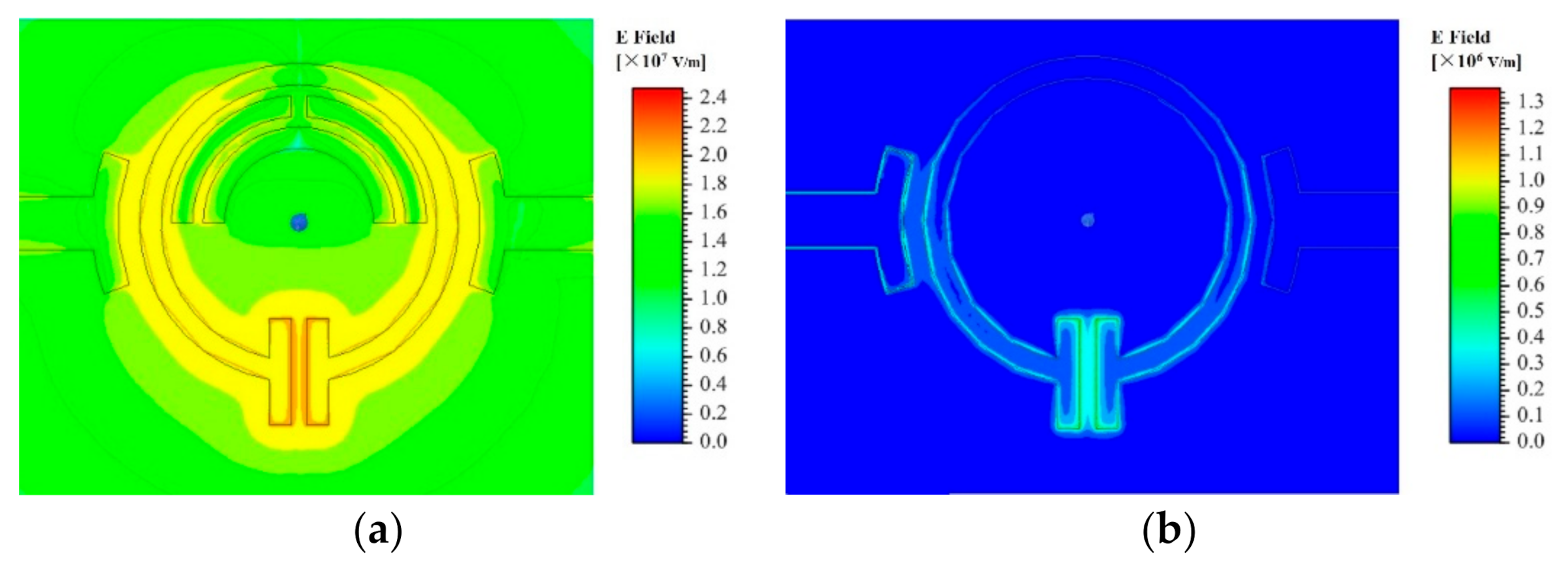
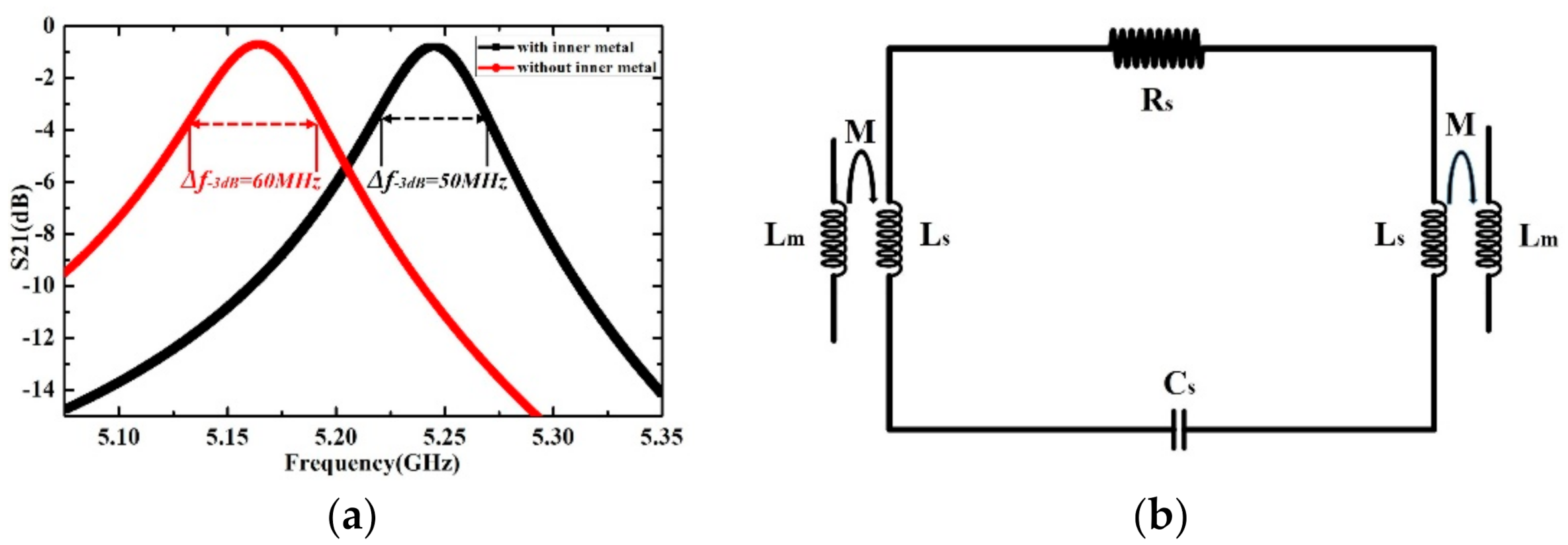

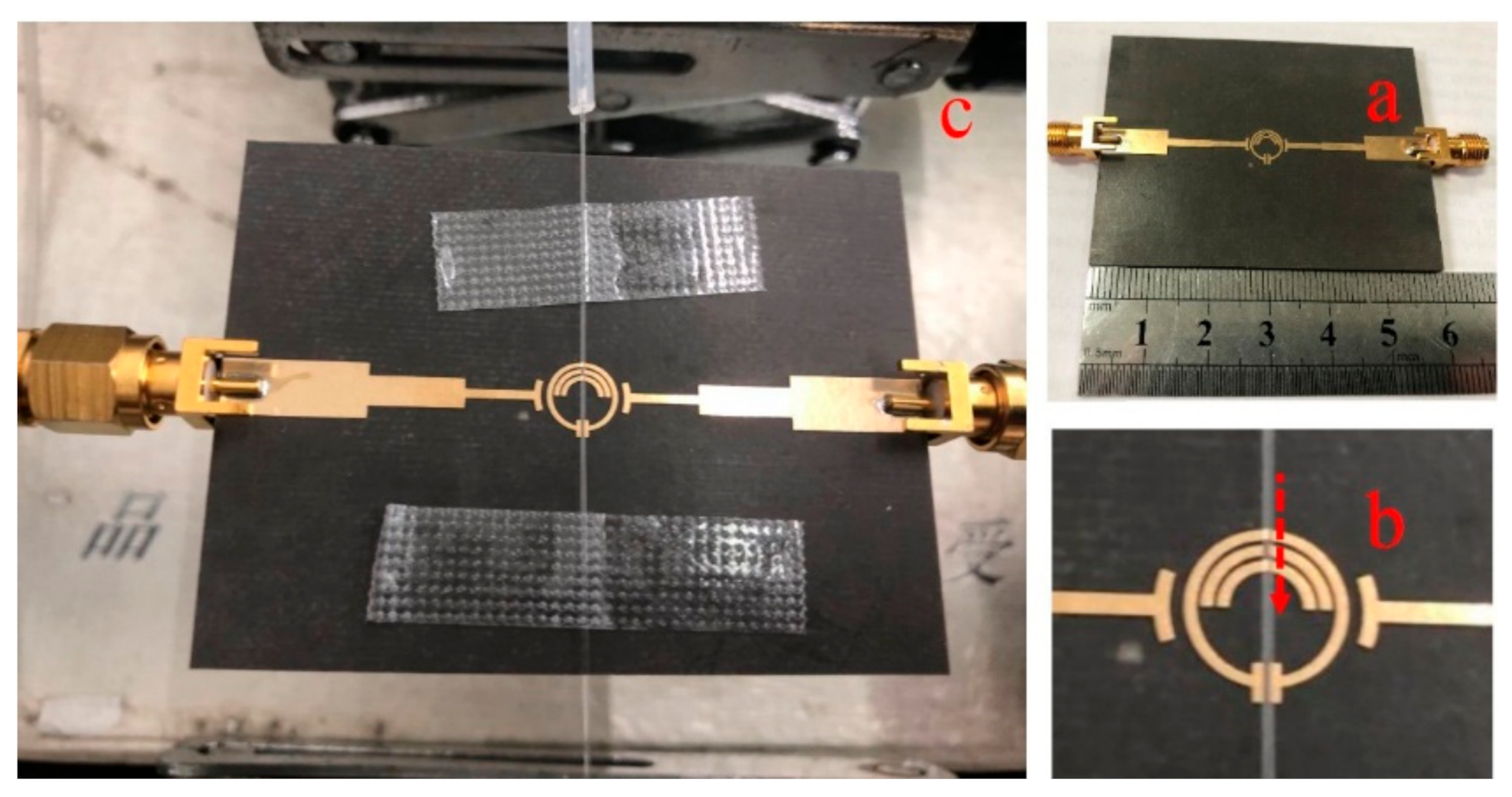
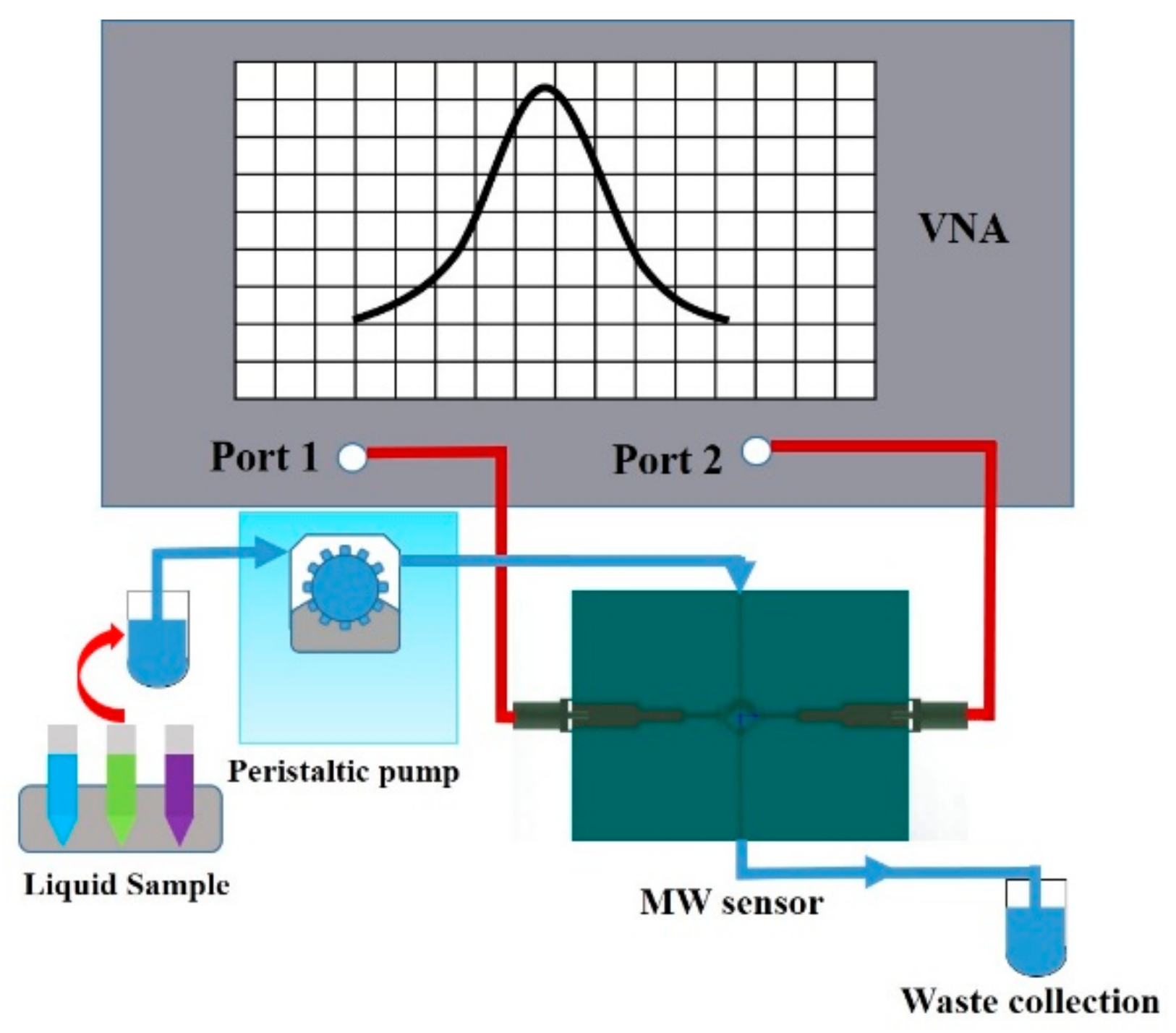
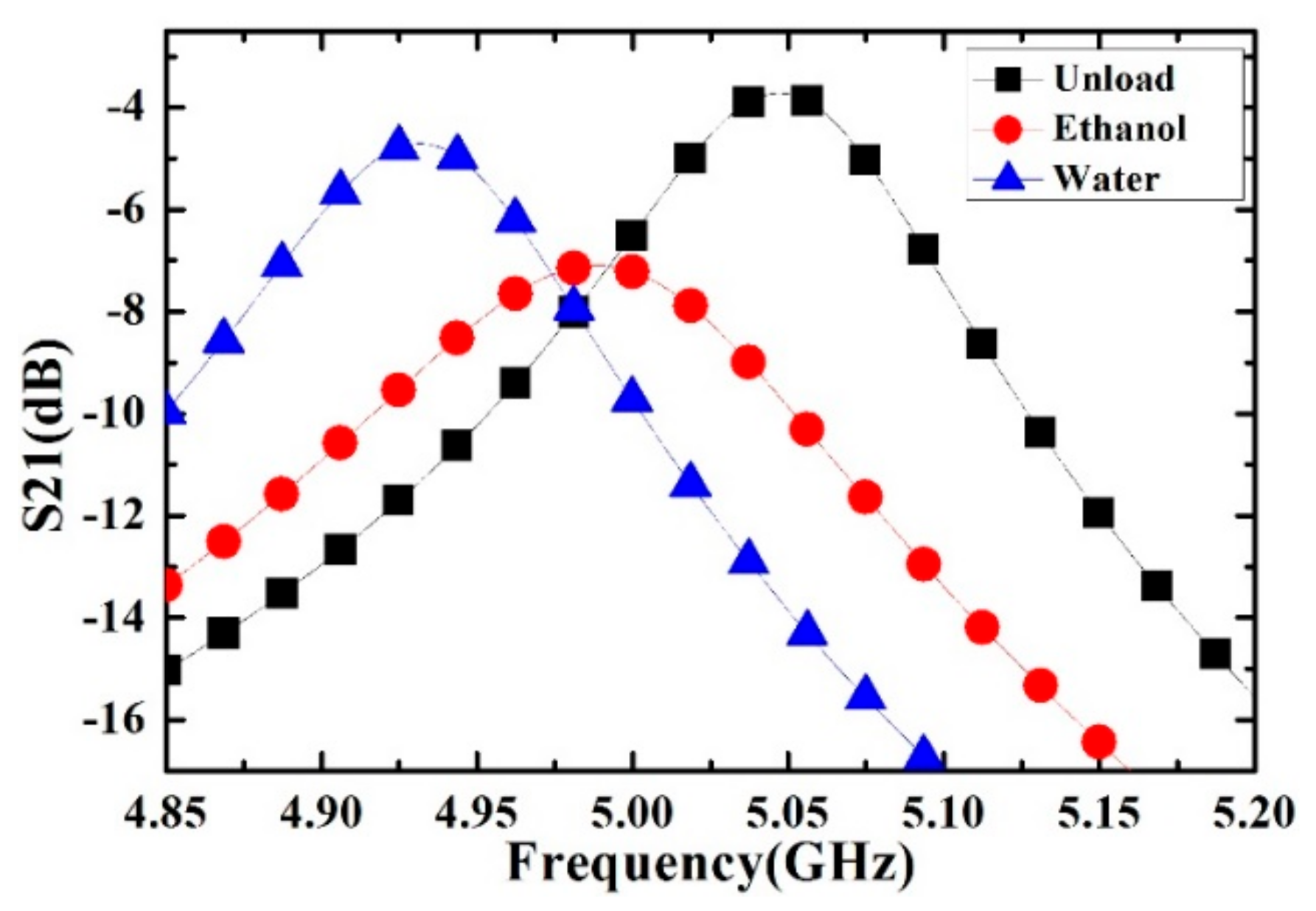
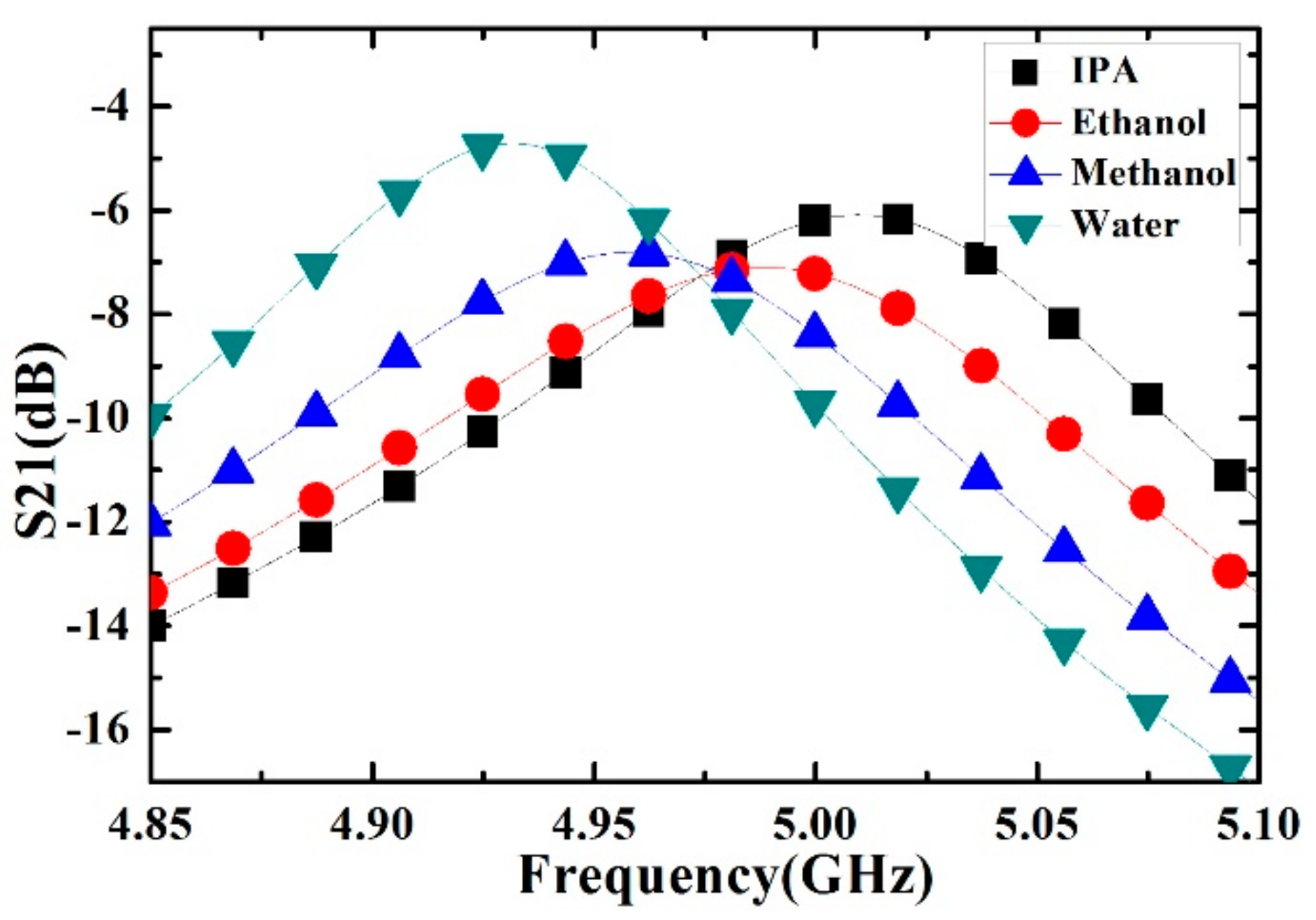
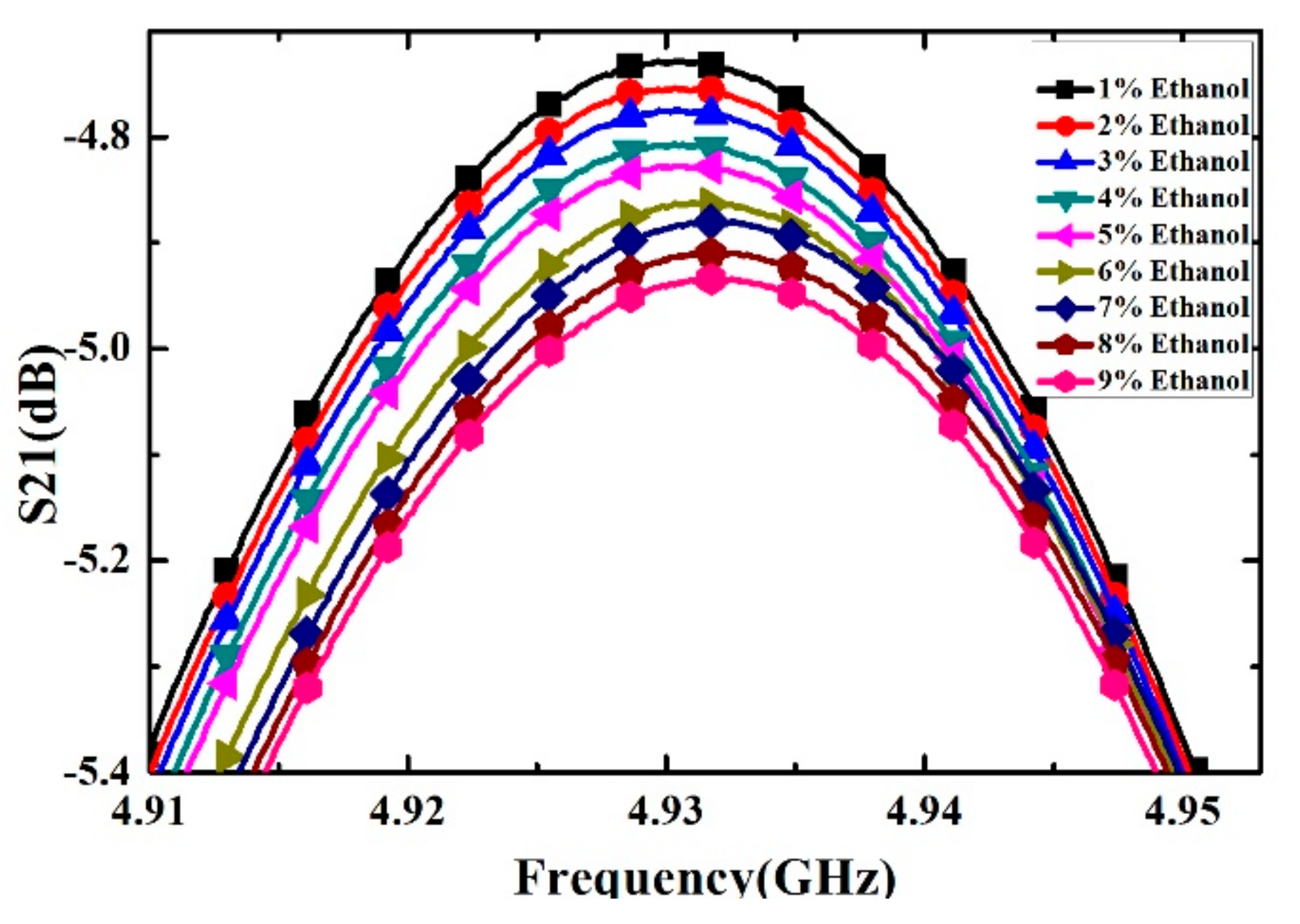
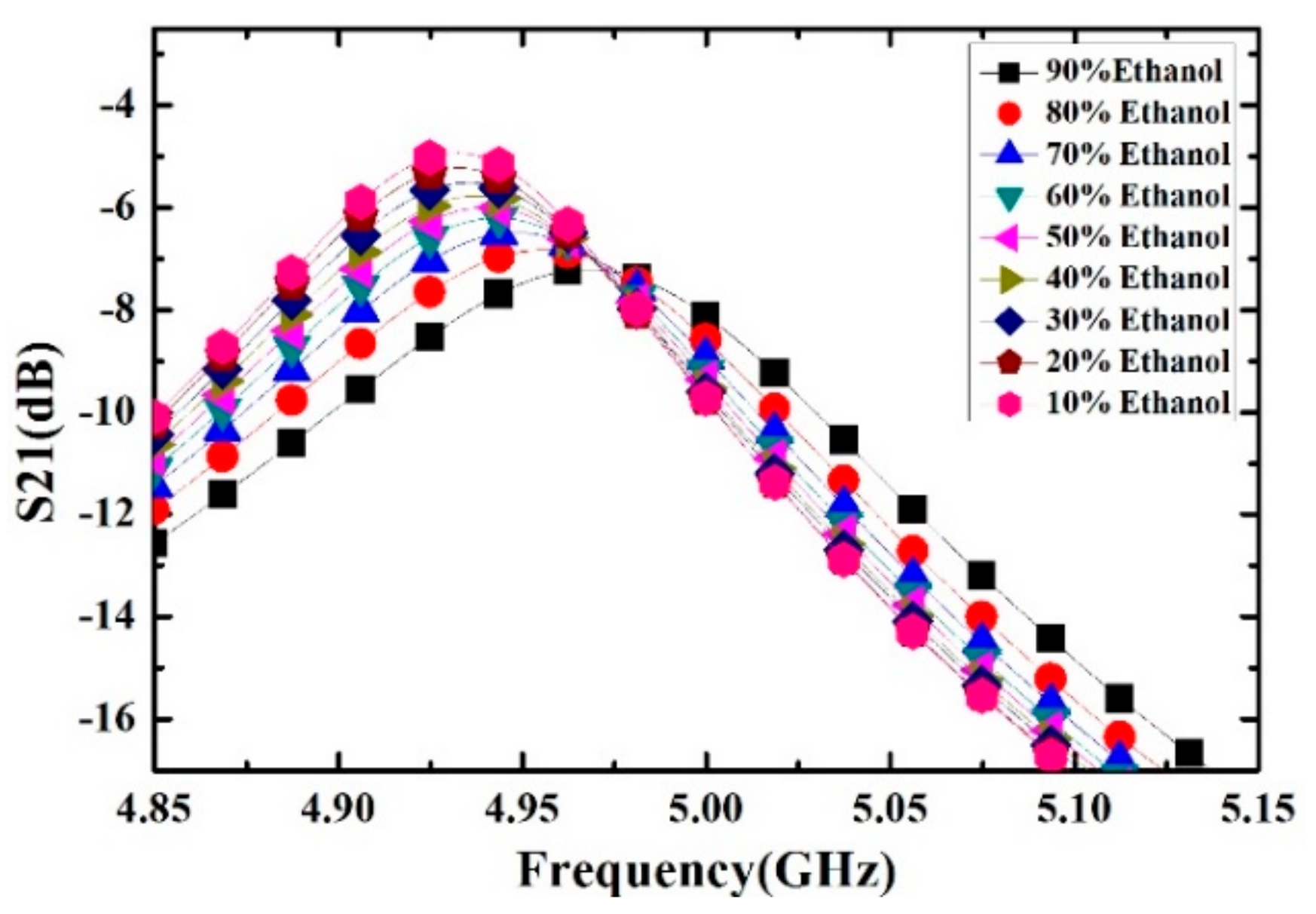
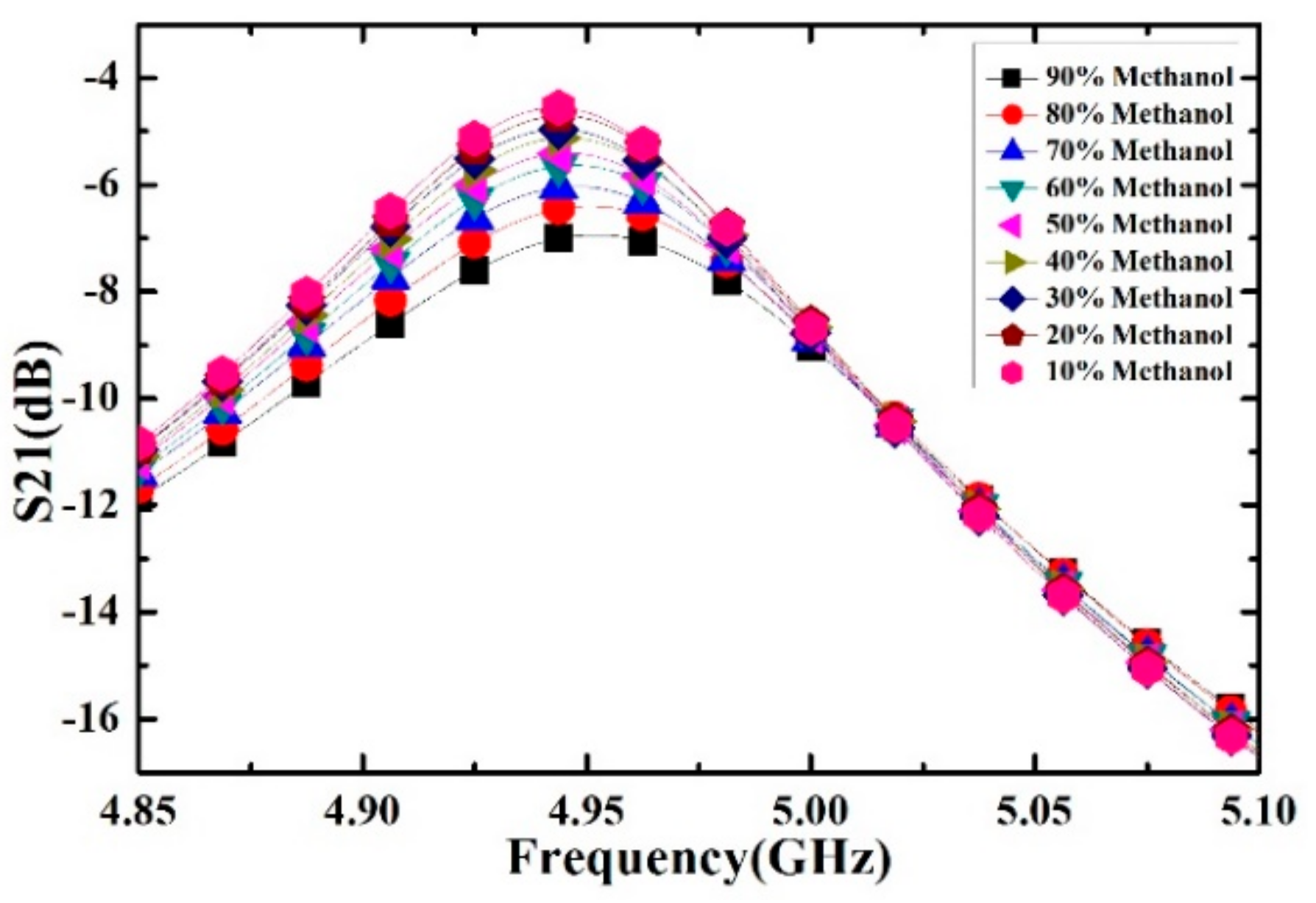
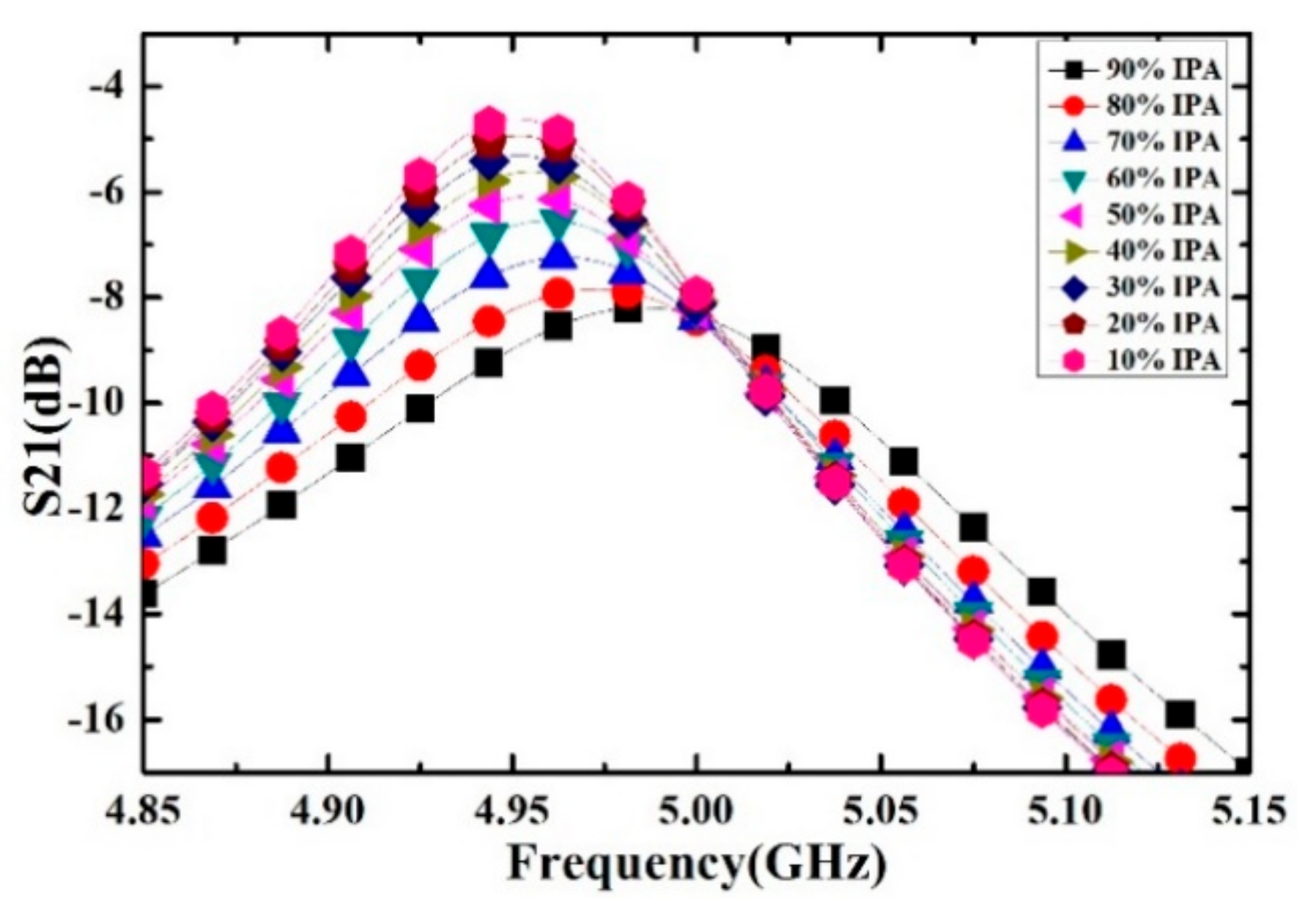

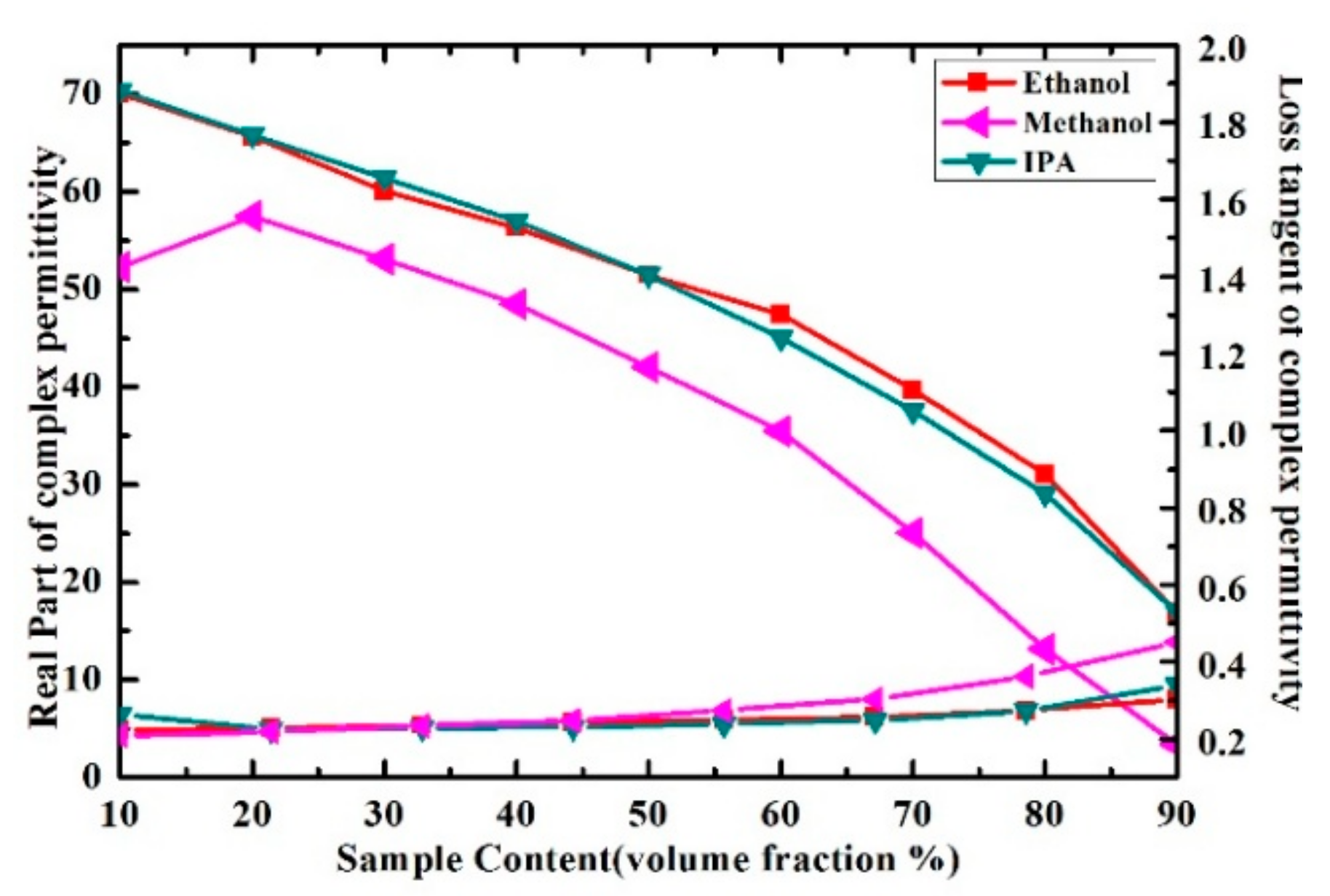
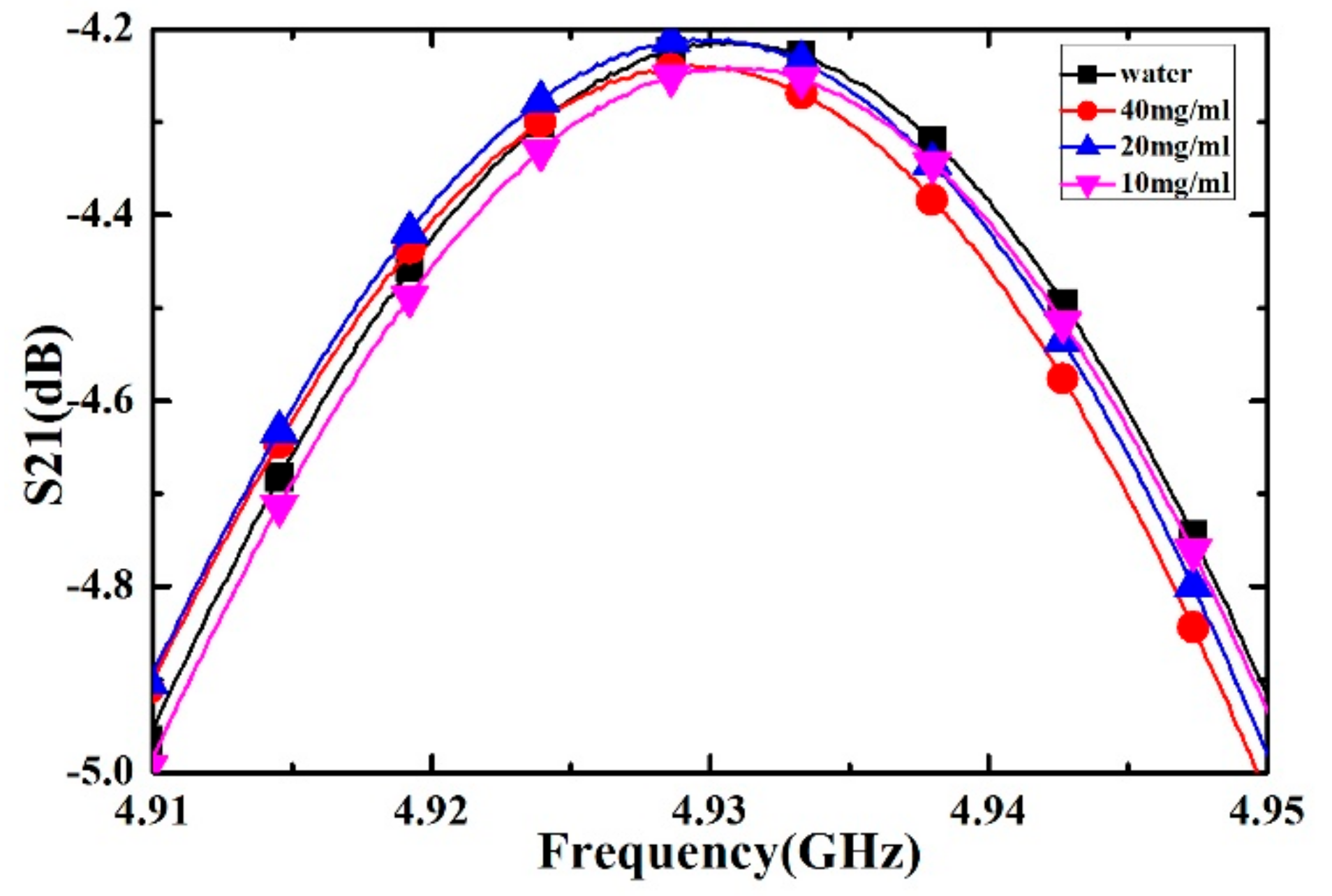

| Parameters | Description | Values (mm) |
|---|---|---|
| w_1 | The width of first coupling line | 4.8 |
| w_2 | The width of second coupling line | 1.4 |
| w_3 | The width of third coupling line | 0.6 |
| w_4 | The width of coupling feedline | 0.5 |
| w | The width of SRR structure line | 0.4 |
| gap_1 | The gap length between coupling line and SRR | 0.6 |
| gap_2 | The gap length of coupling zone | 0.3 |
| gap_3 | The gap length between SRR line | 0.2 |
| w_c | The width of coupling zone | 0.4 |
| l_c | The length of coupling zone | 2 |
| r_1 | The radius of outer SRR line | 3 |
| r_2 | The radius of inner SRR line | 2.4 |
| Sample | ε∞ | τD (ps) | ΔεD |
|---|---|---|---|
| Ethanol | 4.68 | 143.18 | 20.57 |
| Methanol | 6.58 | 52.63 | 26.66 |
| Isopropanol | 2.48 | 25.86 | 15.68 |
| Deionized Water | 4.55 | 7.37 | 72.56 |
| Sample | Frequency Shift (MHz) | Q-Factor |
|---|---|---|
| Empty | - | 52.755 |
| Ethanol | 58.7 | 36.069 |
| Methanol | 89.6 | 37.940 |
| Isopropanol | 38.0 | 40.486 |
| Deionized Water | 116.9 | 49.644 |
| Sample | Frequency Shift (MHz) | Q-Factor |
|---|---|---|
| Empty | - | 52.755 |
| 1% Ethanol | 116.73 ± 0.3 | 49.651 ± 0.421 |
| 2% Ethanol | 116.65 ± 0.2 | 49.489 ± 0.254 |
| 3% Ethanol | 116.64 ± 0.2 | 49.346 ± 0.213 |
| 4% Ethanol | 116.56 ± 0.3 | 49.151 ± 0.416 |
| 5% Ethanol | 116.52 ± 0.2 | 49.083 ± 0.189 |
| 6% Ethanol | 116.39 ± 0.1 | 48.862 ± 0.233 |
| 7% Ethanol | 116.19 ± 0.1 | 48.665 ± 0.205 |
| 8% Ethanol | 116.07 ± 0.2 | 48.577 ± 0.241 |
| 9% Ethanol | 115.91 ± 0.2 | 48.512 ± 0.322 |
| Sample | Frequency Shift (MHz) | Q-Factor |
|---|---|---|
| Empty | - | 52.755 |
| 10% Ethanol | 115.7 | 48.443 |
| 20% Ethanol | 114.6 | 46.710 |
| 30% Ethanol | 111.6 | 44.989 |
| 40% Ethanol | 110.7 | 43.528 |
| 50% Ethanol | 107.1 | 42.361 |
| 60% Ethanol | 104.6 | 41.244 |
| 70% Ethanol | 98.0 | 39.674 |
| 80% Ethanol | 91.0 | 37.823 |
| 90% Ethanol | 79.0 | 34.927 |
| Sample | Frequency Shift (MHz) | Q-Factor |
|---|---|---|
| Empty | - | 52.755 |
| 10% Methanol | 106.1 | 51.283 |
| 20% Methanol | 104.6 | 50.274 |
| 30% Methanol | 105.2 | 48.891 |
| 40% Methanol | 103.8 | 47.925 |
| 50% Methanol | 103.6 | 46.283 |
| 60% Methanol | 100.9 | 45.007 |
| 70% Methanol | 101.3 | 42.753 |
| 80% Methanol | 98.5 | 40.882 |
| 90% Methanol | 94.7 | 38.159 |
| Sample | Frequency Shift (MHz) | Q-Factor |
|---|---|---|
| Empty | - | 52.755 |
| 10%IPA | 98.4 | 50.840 |
| 20% IPA | 96.7 | 48.959 |
| 30% IPA | 96.6 | 46.747 |
| 40% IPA | 94.6 | 45.076 |
| 50% IPA | 92.1 | 42.611 |
| 60% IPA | 89.5 | 40.147 |
| 70% IPA | 84.0 | 36.685 |
| 80% IPA | 74.8 | 33.762 |
| 90% IPA | 65.2 | 32.071 |
| Sample Form | Frequency (GHz) | Frequency Shift (MHz) | Volume (μL) | Sensitivity S (MHz/ε′sam/μL) |
|---|---|---|---|---|
| Ethanol liquid | 4.60 [34] | 70 | 1 | 12.73 |
| Ethanol liquid | 4.20 [33] | 240 | 5 | 9.09 |
| Ethanol Gas | 4.20 [37] | 150 | Null | Null |
| Ethanol liquid | 5.05 (our work) | 58.7 | 0.13 | 97.46 |
| Methanol liquid | 5.05 (our work) | 89.6 | 0.13 | 54.62 |
| IPA liquid | 5.05 (our work) | 38.0 | 0.13 | 182.36 |
| Sample | Frequency Shift (MHz) | Q-Factor |
|---|---|---|
| Empty | - | 52.755 |
| 10 mg/mL Inositol | 117.3 | 49.564 |
| 20 mg/mL Inositol | 118.1 | 49.486 |
| 40 mg/mL Inositol | 118.6 | 49.446 |
Publisher’s Note: MDPI stays neutral with regard to jurisdictional claims in published maps and institutional affiliations. |
© 2021 by the authors. Licensee MDPI, Basel, Switzerland. This article is an open access article distributed under the terms and conditions of the Creative Commons Attribution (CC BY) license (https://creativecommons.org/licenses/by/4.0/).
Share and Cite
Ma, J.; Tang, J.; Wang, K.; Guo, L.; Gong, Y.; Wang, S. Complex Permittivity Characterization of Liquid Samples Based on a Split Ring Resonator (SRR). Sensors 2021, 21, 3385. https://doi.org/10.3390/s21103385
Ma J, Tang J, Wang K, Guo L, Gong Y, Wang S. Complex Permittivity Characterization of Liquid Samples Based on a Split Ring Resonator (SRR). Sensors. 2021; 21(10):3385. https://doi.org/10.3390/s21103385
Chicago/Turabian StyleMa, Jialu, Jingchao Tang, Kaicheng Wang, Lianghao Guo, Yubin Gong, and Shaomeng Wang. 2021. "Complex Permittivity Characterization of Liquid Samples Based on a Split Ring Resonator (SRR)" Sensors 21, no. 10: 3385. https://doi.org/10.3390/s21103385
APA StyleMa, J., Tang, J., Wang, K., Guo, L., Gong, Y., & Wang, S. (2021). Complex Permittivity Characterization of Liquid Samples Based on a Split Ring Resonator (SRR). Sensors, 21(10), 3385. https://doi.org/10.3390/s21103385





